A survey coordinated by Diana Marincu and Maria Sârbu
The sixth edition of the Art Encounters Biennale, titled “Bounding Histories. Whispering Tales” took place in Timișoara from May 30 to July 13, 2025, across three historically significant venues: the Garrison Command, Faber, and the Art Encounters Foundation. The curatorial proposal, centered on the idea of echo, was developed by Ana Janevski and Tevž Logar, two curators with impressive international careers.
This survey gathers the personal reflections of the biennale’s mediators on works that sparked lively dialogues and deep interactions with the audience. Mediation has been a priority for the Art Encounters Foundation since the biennale’s first edition in 2015.
After ten years of consistent involvement by our young collaborators—future cultural professionals or emerging artists—we felt the need to document a fragment of their experience in this essential process of facilitating the understanding of exhibitions. Their voices bring fresh energy, and the perspectives shaped through encounters with the works and the audience offer a more nuanced picture of how art is perceived and discussed.
THE GARRISON COMMAND
Antonia-Maria Bici
Antonia-Maria Bici Veronika Hapchenko’s Golden Fountain is a work that has a powerful impact on visitors at first glance, dominating the space through its size, color scheme, but especially through its wavy, organic, and repetitive texture, with an almost three-dimensional appearance. Behind the visual elements lies a political and historical substrate whose echoes can still be felt today. The work is a critical reference to the Friendship of Nations Fountain in Moscow. The monumental fountain, built in the 1950s, was intended to be a symbol of unity and prosperity, but Veronika Hapchenko’s creation speaks of the painful reality of the former USSR. The skeletal female figure at the center of the composition can be seen as a direct reference to the Soviet famine of the 1930s, which profoundly affected several Soviet republics, including Ukraine, the artist’s country of origin.
Antonia-Maria Bici (b. 1999), graduate of the Faculty of Architecture and Urbanism, Polytechnic University of Timișoara
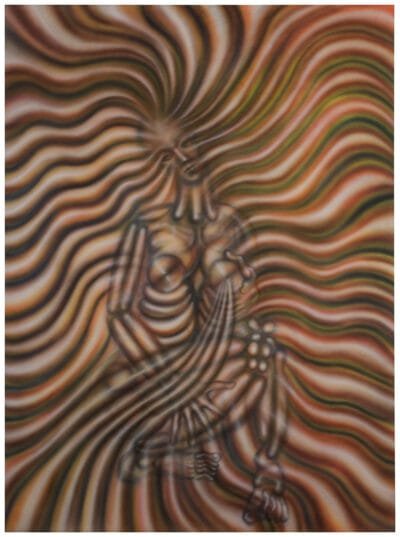
Veronika Hapchenko – Golden Fountain, 2023 acrylic and ink on canvas, 215 x 155 cm Private collection
Carina Pîrva
This work means a lot to me because it gave me the opportunity to have a variety of conversations with visitors of all ages, from students to seniors. The idea for the installation stems from the fact that we are bombarded with so much information, whether we like it or not, that we often end up no longer engaging in critical thinking, no longer discerning. It is a highly topical work that conveys a simple message, but one that is so direct and powerful that most visitors, regardless of age and experience, recognize its significance. My favorite thing to do with visitors is to walk through the space among these newspapers and analyze what the artist saw while he was at the shooting range. It is a process that helps us delve even deeper into the artist’s reasoning and emotions, which many of us share.
Carina Pîrva (b. 2000), graduate of the Advertising and Book Graphics department of the Faculty of Arts and Design in Timișoara
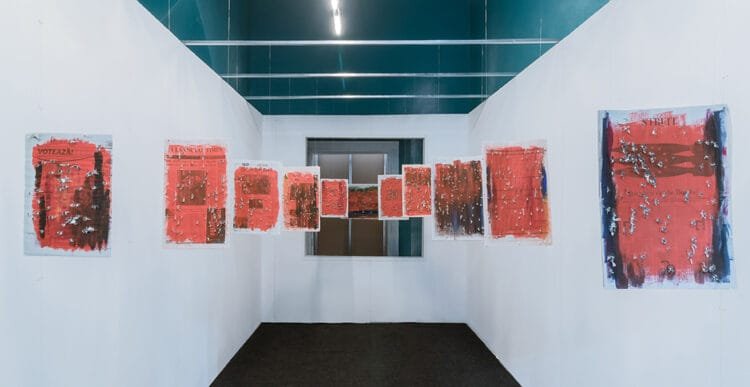
Pavel Brăila – Times When News Are Faster Than Bullets, 2025 Series of 12 paintings, acrylic paint on pressed newspapers shot with 9mm gun, 60×40 cm
Alexandra Costea
This is not an installation – Mihai Toth’s initiative – opens a discourse that transcends the framework of the biennial. The work proposes a collective gesture: visitors take snapshots of fragments from the exhibition, print them, and place them in a shared space, creating a living archive of their own perceptions and an affective map of presence.
Each image becomes the echo of a lived moment – unique, irrepeatable – that preserves the subjective reverberation of the encounter with the works. Participation becomes a form of active remembrance, and the accumulation of these varied perspectives shapes a fluid memory, both personal and collective.
The multiplication of these points of view builds a living space for dialogue and continuity. All images and gestures leave an imprint in this shared archive, which is constantly changing. The installation thus becomes fertile ground for reflection, a living story that promises reactivations in other cultural contexts.
Alexandra Costea (b. 2000), PhD student at the Timișoara Doctoral School of Arts, with a thesis on the memory of place in New Media Art installations
Ana Crețu
Cristina Cizmaș’s installation, Between Walls and Words, relies on establishing a strong connection with the audience, appealing to elements of familiarity and the possibility of generating empathy.
To begin with, the props in the room, the lamps, the carpet, the table, represent a welcoming setting, evoking the interiors of old family homes and instantly arousing curiosity. What’s more, the story of her mother’s letters, her youthful love, her openness about her family history, and, most importantly, the close mother-daughter relationship became a starting point for many conversations with the audience. From memories of old correspondence with loved ones to recollections from her time in the army, images of her parents’ house, but also the glimmer of understanding in her eyes when confronted with the idea that her mother, beyond her maternal figure, is a woman with a personal history.
This installation represents not only a window into the artist’s intimate life, but also a “bubble” of comfort within the biennial – a space of micro-histories, flanked by other works that address harsh themes of macro-history.
Ana Crețu (b. 2004), second-year student specializing in Graphics at the Faculty of Arts and Design in Timișoara
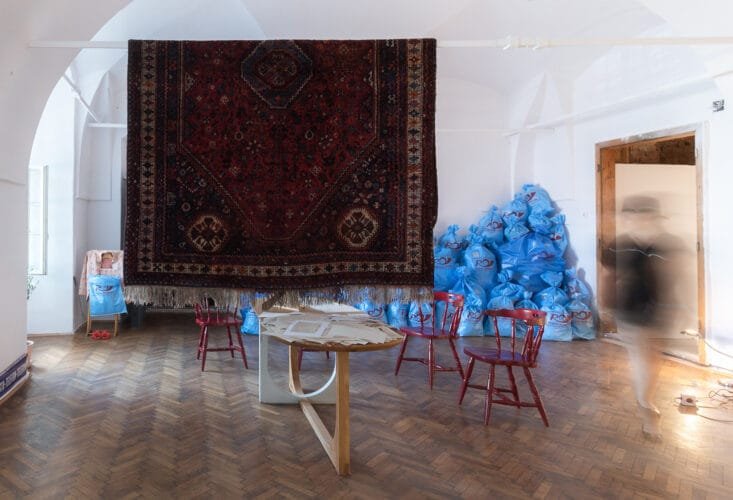
Christine Cizmaș – Between Walls and Words, 2024 / 2025 Installation, performance, variable dimensions
Alessandra Domuța
Inspired by the premodern beginnings of Timișoara, Ana Adam proposes, through her work It’s all (her)stories, an imaginary dialogue with historical figures significant to the city’s past – Eugene of Savoy and Florimond de Mercy.
The textile triptych stands out through the delicacy of its materials and the way it stitches a playful correspondence between these characters and the artist’s own alter ego.
Without judgment or labeling, Ana Adam approaches history with openness and curiosity, setting aside binary classifications such as “good/bad” or “conqueror/liberator.” Her work reinterprets the past from a feminine and sensitive perspective, foregrounding the connection between major historical events and intimate emotional experiences. For the artist, history is not a fixed chronology but a living space in which past and present can engage in dialogue, and multiple perspectives coexist harmoniously.
Alessandra Domuța (b. 2006), first-year student in the Graphics program at the Faculty of Arts and Design, Timișoara
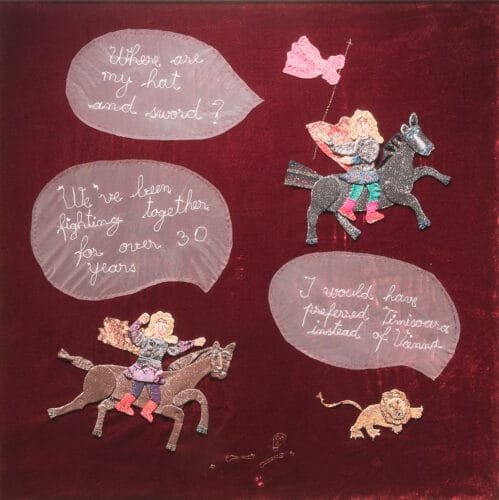
Ana Adam – It’s all (her)stories, 2025 New and recycled fabrics, textile threads, beads, sequins, 100 x 300 cm (unframed)
Claudia Ignat
The work Taki Pejzaż (Such a Landscape) by artist Dana Kavelina deeply moved me.
The film’s starting point is a Yiddish song composed and sung during the First World War in Poland—a song about famine, later rediscovered during the Holocaust. The melody uses the metaphor of the wind as a symbol of destruction, which ravages homes, roofs, crops, and trees, leaving behind a desolate landscape.
What drew me to this work is the depth of the message the artist manages to convey through this material, even if, at first glance, it might appear as merely a form of entertainment. In reality, it holds multiple layers of interpretation. It indirectly addresses themes of migration, the violence of war, and, most importantly, highlights the role of the victim as a political subject.
Claudia Ignat (b. 2001), graduated in 2025 from the Decorative Arts program at the Faculty of Arts and Design, Timișoara
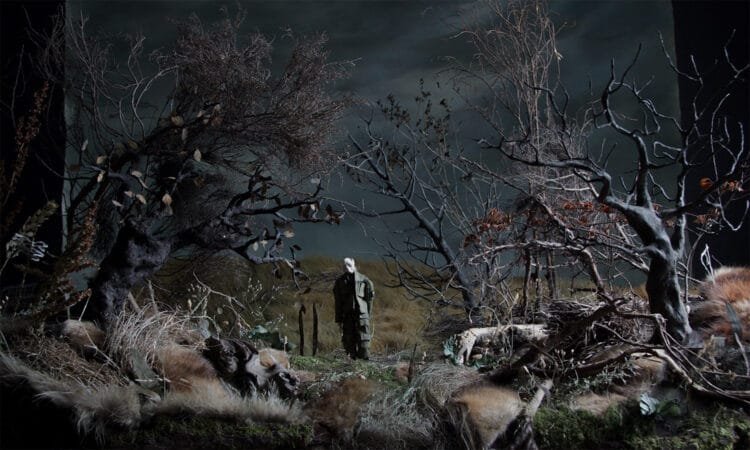
Dana Kavelina – Taki Pejzaz, 2023 Stop-motion animation, 16×9 cm Duration 12:02
Andreea Ioniță
Kapwani Kiwanga’s work stands out through the apparent simplicity of its gesture and the symbolic weight it carries.
The act of moving soil from outside the exhibition space into the interior – and then, with the help of the audience, back outside – becomes both a ritual of repair and a meditation on memory, belonging, and transformation through collaboration and human engagement.
As a mediator and artist, I often spoke with visitors about what it means to “take something back” and whether it is possible to rebuild a connection to the land, to place, to the past. Each participant, holding the ceramic vessel, becomes part of a collective process, nearly silent, yet deeply meaningful. For me, the work succeeds in transforming a physical action into a form of empathy toward nature, communities, and the traces we leave as a legacy in shared spaces and collective experiences over time.
Andreea Ioniță (b. 2000), graduated in 2024 from the Advertising and Book Graphics program at the Faculty of Arts and Design, Timișoara
Erik Kun
One of the most impactful works in the biennial is Karpo Godina’s 1971 film Healthy People for Fun, which speaks to the multicultural and multiethnic identity of Vojvodina. It conveyed to me a very personal feeling of nostalgia, reminding me of the older generation I grew up with, a world that no longer exists today.
This video work evokes for me a distant reality, traces of which I seek with pleasure and curiosity in my own current projects.
Erik Kun (b. 1999), graduated in 2023 from the Painting program at the Faculty of Arts and Design Timișoara
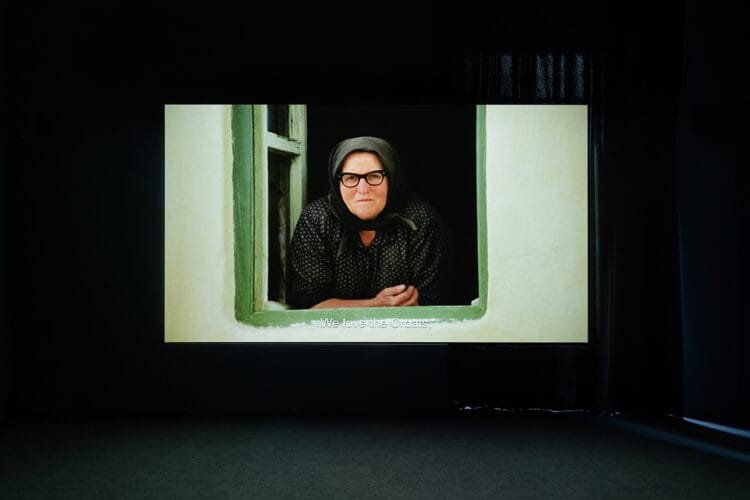
Karpo Godina – Healthy People For Fun, 1971 35mm film, color, duration 14:00
Mihai Toth
A work like an iceberg, on the surface we only see the tip, through the modesty and minimal necessity of the materials used, but inside lies a monumental content, through the powerful message of the gesture shaped in the context of the biennial. This is the feeling I experienced through In-between, the intervention by Ghenadie Popescu, a 10:08-minute video performance created in 2010.
“What a claustrophobic place!”, “Why is he whistling?”, “There should’ve been another fake door…”, “What is the MD on his head?”, “Do we all fit in here?”, “Hahahaaaa…”, “Brilliant, a superb idea!”, “Does the artist know all those who pass through there?”, “He moves like a spinning top”, “Is it staged?”, “Feels like we’re there with him” — these are just a few of the spontaneous reactions from visitors stepping into Ghenadie’s dedicated space, a narrow area with a flat screen placed on the floor, in the center of the room.
The image shows the artist in a small hallway, a transitional space found at the entrances of older houses and institutions, where opening one door leads to another. Yes, it relates to Moldova, but not only. The work evokes not only a need to contemplate the idea of borders and the absurdity of the reality in which social structures often compel us to remain still, shrouded in uncertainty and instability, but also speaks to how the state of perpetual transition can be identified through the tension between action and stagnation, freedom and constraint. Another example of how the body and space become one and the same, two elements that enhance each other, conveying together a dynamic and immersive experience, universally resonant, in which the visitor performs alongside the artist.
Mihai Toth (b. 1990), PhD candidate at the Faculty of Arts and Design Timișoara, with a dissertation on researching the void through body and space
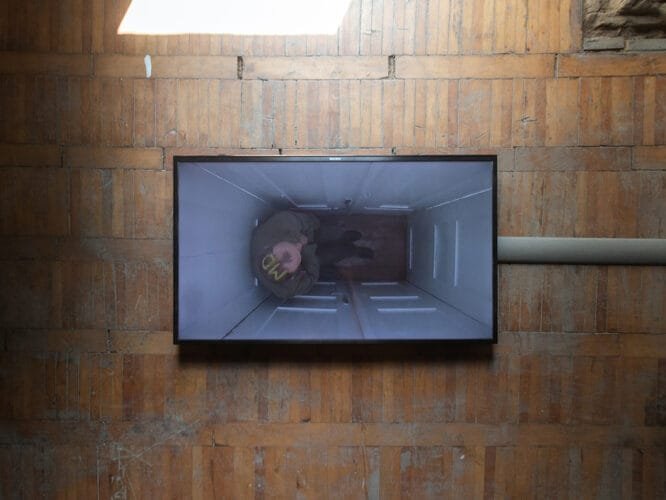
Ghenadie Popescu, In-between, 2010. Video, duration 10:08. Courtesy of the artist. Photo by David Dumitrescu.
FABER
Ioana Bartha
Siniša Ilić’s work Homes of Culture begins with the reinterpretation of a mosaic created in 1969 in the Cultural Center of Novi Pazar and expands this investigation into the legacy of cultural institutions from the socialist era. The central canvas, which dominates the space, functions as an imaginary backdrop, a mental screen onto which viewers can project their own memories, projections, or needs related to public cultural spaces. According to the artist, this canvas had previously been used as a backdrop for various artistic events. Starting from this detail, I often discussed with visitors and fellow mediators how the work, through its physical scale and symbolic charge, becomes itself a fragment of imaginary architecture. A possible wall of a house of culture, around which a fleeting community might take shape. In this sense, the installation documents or reinterprets the past of these institutions and directly participates in the activation of a contemporary collective space.
I became genuinely attached to this work, because I had the opportunity to meet the artist, which gave me a deeper understanding of his intentions. The work activated the memory of past personal experiences: the House of Culture in Bistrița (currently the Palace of Culture), a place that served as a binding force for the local community, where I saw my first theater performance, my first symphonic concert, where I stepped on stage for the first time.
Ioana Bartha (b. 2001), graduated in 2025 from the master’s program in Heritage, Restoration, and Curating, Faculty of Arts and Design Timișoara
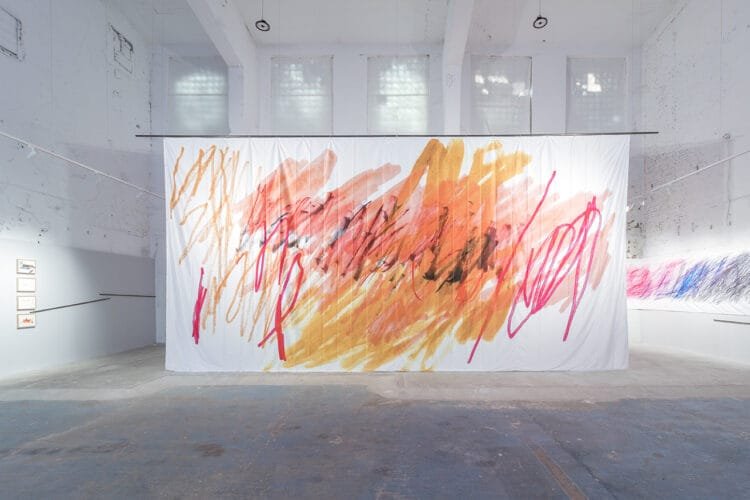
Siniša Ilić – Homes of Culture, 2021 / 2022 Space installation, objects, prints on textile, watercolors Textiles: 4,5 x 9,5 m & 160 cm x 8,80 m 16 watercolors: 24 x 32 cm Video duration 4:00
Ingrid Pescaru
Zifzafa, the work of Jordanian artist Lawrence Abu Hamdan, is a multimedia installation that blends investigative journalism with contemporary art and sound design. These components are integrated by the artist into an interactive format, in the form of a simulation inspired by the aesthetics of video games.
The project tells the story of the Jawlani Syrian community, who oppose the installation of 31 wind turbines on the territory they inhabit. The installation of these turbines is a measure initiated by the Israeli government, resulting in the deterioration of living conditions in the area and the increased hardship faced by the community, as the noise produced by the turbines is unbearable. What gives the work its remarkable character is the chosen format: the digital simulation allows for an immersive reconstruction of the site’s acoustic reality, offering the viewer not just a representation, but an experience.
Sound is the main focus of this work, and what impressed me most is the way the video game – the simulation format – is used to document and explore sound within the project’s context. This strategy of artistic mediation makes the subject – deeply political and charged with social tension – accessible to a wide audience, without diminishing its complexity.
Ingrid Pescaru (b. 2001), graduate of the Painting department at the National University of Arts Bucharest
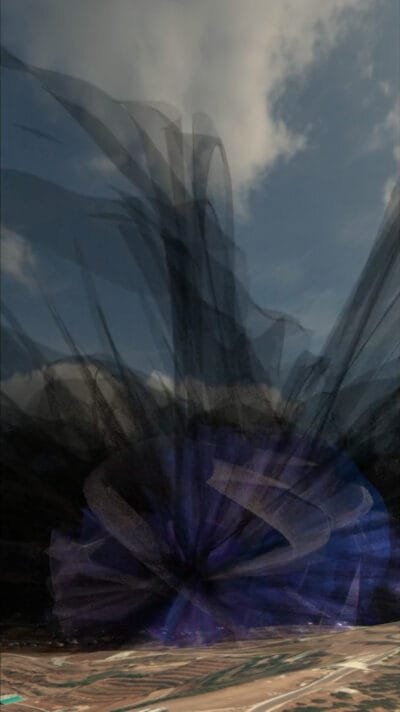
Lawrence Abu Hamdan – Zifzafa: A Livestream Audio Essay 2024 Video (color, sound), variable dimensions (projection ratio 32:19)
THE ART ENCOUNTERS FOUNDATION
Mihail Riglea
Larissa Sansour’s work has become, for me, that corner of the exhibition that I choose, on every tour, to leave for the end. It is a repeated choice, not out of lack of interest, but quite the opposite, I want to present it last precisely so I can engage in deeper discussion, without the pressure of time or of other works still to come. Archeology in Absentia is a work I find perfectly suited to the conceptual framework of this year’s biennial, both in the way it transcends history, like a penetrating reverberation, and in its spatial correspondence, which intersects two mediums and uses them as a means of transforming meaning.
Through the effort to preserve a cultural identity, at the level of symbol, I notice a tangible form of care that becomes a point of convergence with the imprint and history of the space in which it is exhibited.
Mihail Riglea (b. 2005), second-year student in the Graphics program at the Faculty of Arts and Design
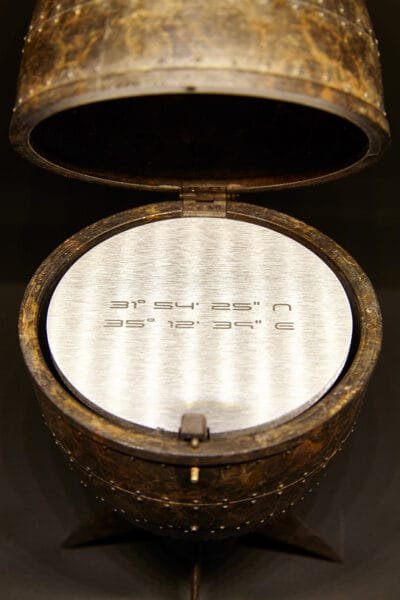
Larissa Sansour – Archeology in Absentia Bronze, aluminum 10 sculptures, 20x10cm (each sculpture)
Translated by Marina Oprea
POSTED BY
Redacția Revista ARTA
The team of young editors, working together towards a better understanding of Romanian contemporary art!...
revistaarta.ro